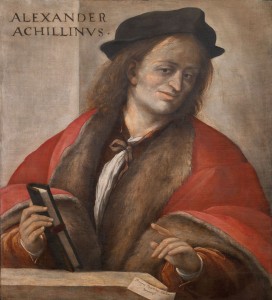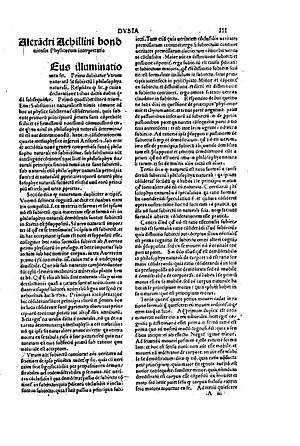Alessandro Achillini facts for kids
Alessandro Achillini was an Italian philosopher and physician. He was born around 1463 and passed away on August 2, 1512. He is especially known for his important studies of the human body, called anatomy.
Biography
Alessandro Achillini was born in Bologna, Italy, and spent most of his life there. He came from an old family in Bologna. He became famous as a teacher of both medicine and philosophy at the University of Bologna and the University of Padua. People even called him the "second Aristotle" because he was so smart.
Achillini was a very honest and straightforward person. He wasn't good at flattery or trickery. Sometimes, his clever students would even tease him, but they still respected him as a teacher. He was also a cheerful and happy person. A colleague described him as handsome, tall, and always smiling. Achillini never got married. His colleagues admired him greatly. Even though he was very knowledgeable and great at debates, his lectures could be a bit formal. Many people were very sad when he passed away.
He died in Bologna on August 2, 1512, and was buried the next day.
Achillini made several important discoveries about the human body:
- He was the first anatomist to describe two small bones in the ear, called the malleus and incus.
- In 1503, he showed that the middle part of the foot, called the tarsus, has seven bones.
- He rediscovered parts of the brain called the fornix and the infundibulum.
- He also described the tubes that carry saliva from the glands under the jaw.
Alessandro's brother was a writer named Giovanni Filoteo Achillini. His grandnephew, Claudio Achillini, became a lawyer.
In 1506, Achillini had to leave Bologna. This was because a powerful family he supported, the Bentivoglio family, was forced out of the city. He then went to Padua, where he became a philosophy teacher.
Career
Alessandro Achillini started teaching when he was 21 years old. From 1484 to 1512, except for two years, he was a professor of Medicine or Philosophy at the University of Bologna. During those two years (1506-1508), Achillini taught at the University of Padua. He taught at Bologna for 28 years, which was longer than almost anyone else in medicine or philosophy there.
At the University of Padua, professors could be fined if they missed teaching days or didn't have enough students. Achillini faced some penalties for not meeting these requirements during a few months in 1506-1507. He also received strong letters from Bologna, warning him about unauthorized absences.
Achillini was often part of committees that examined students for their doctoral degrees. Records show he attended these important meetings at least 90 times. These meetings were for approving new doctors or electing new members to the group of collegiate doctors.
Achillini was also very knowledgeable about theology, which is the study of religion. He initially thought about becoming a priest. He started his religious studies before 1476. Even though he later focused on teaching at the university, he remained active in theology throughout his life. He even attended two big meetings of the Franciscan religious order.
While teaching in Bologna, Achillini helped create interest in the ideas of William of Ockham, another famous philosopher. It's believed that Achillini and other teachers at the university helped bring Ockham's ideas back into focus.
See also
 In Spanish: Alejandro Achillini para niños
In Spanish: Alejandro Achillini para niños



